|
|
|
Sort Order |
|
|
|
Items / Page
|
|
|
|
|
|
|
| Srl | Item |
| 1 |
ID:
162281
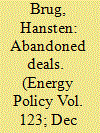

|
|
|
|
|
| Summary/Abstract |
High profile deals emphasize the costs of the merger and acquisition (M&A) process particularly when deals fail before closure. However, beyond anecdotal evidence, we do not know why some M&A deals in the electricity and gas industries are abandoned. We analyze a sample of over 5000 M&As in the electricity and gas industries. The three most important factors affecting M&A abandonment are if the acquirer engaged in a divestiture at the same time, whether the target firm was publicly owned, and if the acquirer already had a toe-hold (part ownership) in the target firm at the time of the M&A deal. An M&A deal is 10.17% less likely to be abandoned if the acquirer engaged in a divestiture at the same time. An M&A involving a publicly owned target firm is 9.87% more likely to be abandoned. Lastly, an M&A in which the acquirer had a toe-hold in the target company is 7.87% more likely to be abandoned. Our findings show that policy makers and practitioners should be aware that the M&A process is affected by often over-looked deal or firm specific factors.
|
|
|
|
|
|
|
|
|
|
|
|
|
|
|
|
| 2 |
ID:
162270
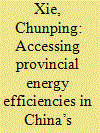

|
|
|
|
|
| Summary/Abstract |
The transport sector is attracting increasingly attention in the context of climate change and sustainable development, for its rapidly growing demand for energy and heavy reliance on oil products. Especially in China, where the demands for transportation are tremendous and ever-increasing, it is worthy to explore the provincial variations in energy efficiency in the transport sector, in order to enhance energy efficiency and to promote energy savings in this sector. By using stochastic frontier analysis (SFA) approach, this paper calculates the provincial energy efficiency as well as energy saving potential in China’s provincial transport sector over 2007–2016. Results suggest that China’s national average energy input efficiency in the transport industry is 0.673 during the sample period, which implied that relatively large degree of non-efficiency exists in this sector. Besides, the increase of government support (GS), the improvement of road condition (RC) and public transport (PT) are influencing factors for the improvement of China’s provincial energy efficiency in the transport industry. Additionally, energy saving potential in the transport sector is also estimated in this paper. It is shown that, although energy efficiency in the eastern China is the highest (much higher than the country-wide level), the estimated absolute amount of the energy saving potential in the eastern area is significantly larger than those in the central area and western area due to the fact that the eastern area contributes to the largest share of the total energy consumption in this sector.
|
|
|
|
|
|
|
|
|
|
|
|
|
|
|
|
| 3 |
ID:
162308


|
|
|
|
|
| Summary/Abstract |
In China, a large private sector has evolved alongside a still sizeable state-owned sector that is subject to government control. Several studies have found that in this mixed economy, the private sector is economically more efficient than the state-owned sector. In this paper, we investigate whether private firms are also more carbon efficient than state-owned firms. Using a macroeconomic panel data model with provincial data from 1992 to 2010, we confirm that private firms emit less carbon dioxide than state-owned firms. Our results imply that future reforms, such as ongoing privatization, introduced to increase the economic efficiency of state-owned companies will also mitigate emissions growth. The policy lesson, not only for China but for developing countries maintaining a large state-owned sector, is that economic efficiency and energy efficiency are conjoined mutual benefits.
|
|
|
|
|
|
|
|
|
|
|
|
|
|
|
|
| 4 |
ID:
162285


|
|
|
|
|
| Summary/Abstract |
Recent broad-based deployment of Advanced Metering Infrastructure (AMI) enables the opportunity for broader adoption of time-based rates, and the benefits that result have been sizable contributors to making the investments cost effective. However, some stakeholders have raised concerns about the assumptions underlying the benefits assessments in AMI business cases. Such concerns are especially acute for certain subpopulations of residential customers. Low income, elderly and chronically ill (i.e., vulnerable) customers are believed to have less load that can be shifted or reduced to capture bill savings, lack the know-how or wherewithal with which to curtail usage, likely have more limited financial resources which may compel them to avoid high priced periods by reducing electricity for essential usage potentially causing them physical harm, and more generally may be more adversely affected by higher bills, which might possibly result from certain forms of time-based rates. There is very limited existing literature that addresses these questions specifically with regard to vulnerable subpopulations. This paper, based on a larger report, extends the existing empirical literature on the experiences of low-income customers exposed to critical peak pricing, and provides the first glimpses into the experiences of the elderly and those who reported being chronically ill.
|
|
|
|
|
|
|
|
|
|
|
|
|
|
|
|
| 5 |
ID:
162327
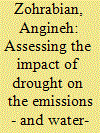

|
|
|
|
|
| Summary/Abstract |
This study investigates how technological transitions across California's power sector have shifted its state-level carbon dioxide emissions and cooling water consumption intensities. Its ultimate goal is to evaluate how the state's climate mitigation and environmental policies have affected the power sector's vulnerability to extreme drought and how extreme drought has affected progress towards the state's climate mitigation priorities. The study analyzes the period spanning 2010–2016, which includes one of the state's most severe droughts on record. The results indicate that the growth of variable renewable energy generation has helped offset some of the negative consequences of drought, which include increased emissions and cooling water usage by natural gas generators during periods of low hydropower. However, the retirement of the San Onofre nuclear power plant has delayed the overall decarbonization of the state's power sector, and the closure of significant coastal power plant capacity could increase the freshwater consumption of the power sector if replacement capacity is not cooled with alternative cooling water sources or dry cooling systems. The noted tradeoffs between greenhouse gas mitigation priorities, freshwater dependency, and vulnerability to climatic events highlight the importance of holistic decision making as regional power grids transition to cleaner generation sources.
|
|
|
|
|
|
|
|
|
|
|
|
|
|
|
|
| 6 |
ID:
162306
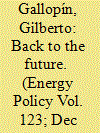

|
|
|
|
|
| Summary/Abstract |
The world system is at an uncertain branch point from which a wide range of possible, qualitatively different, futures could unfold before the end of the Century. Two decades ago, the Global Scenario Group (GSG) published three archetypical sets of scenarios of the future of the planet. These are revisited in the light of the changes and developments that happened since then, plus the emerging new trends, looking for meaningful early warning signals and potential strategic causal nodes that could help steering towards a sustainable global future.
|
|
|
|
|
|
|
|
|
|
|
|
|
|
|
|
| 7 |
ID:
162309
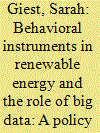

|
|
|
|
|
| Summary/Abstract |
There has been a surge in the application of behavioral insights for environmental policymaking. It is often presented as an easy and low-cost intervention to alter individual behavior. However, there is limited insight into the cost effectiveness of these attempts and the impact of inserting behavioral policy instruments into an existing mix of traditional tools in a particular policy sector. Furthermore, there has been little focus on the intersection of large behavioral datasets and how they could complement behavioral insights. We present a conceptual overview of how the intersection of big data and behavioral knowledge would work in the renewable energy sector. We indicate that inserting behavioral insights into the energy instrument mix is complex due to technological trajectories, path dependencies and resistance from incumbent industries to change production patterns. We also highlight the underutilized role of large behavioral datasets that can inform not only policy implementation, but also policy design and evaluation efforts. Drawing on these findings, we introduce future research streams of government capacity in combining behavioral insights and data, the compatibility of this information with existing policy instruments and how this affects policy change.
|
|
|
|
|
|
|
|
|
|
|
|
|
|
|
|
| 8 |
ID:
162332


|
|
|
|
|
| Summary/Abstract |
An investigation of Poisson type policy jumps on biodiesel investment considers the theory of investment under uncertainty. The analysis studies the probability of implementing a policy if it is not in effect and the probability of withdrawal if it is in effect. An application models the policy-switching regime of the discontinuous U.S. federal tax credit of $1.00 per gallon on biodiesel. Results support that time inconsistent government policies do lead to market uncertainty. The analysis reveals a pronounced negative impact on decisions to invest in a biodiesel refinery. Results do indicate a consistent policy-switching regime may not be that disruptive to the emerging biodiesel industry. It is policy uncertainty that drives the option-pricing thresholds and a consistent policy switching does not increase the uncertainty.
|
|
|
|
|
|
|
|
|
|
|
|
|
|
|
|
| 9 |
ID:
162318


|
|
|
|
|
| Summary/Abstract |
Carbon emissions are posing continuing threats to climate change and becoming the important evaluation indicator for sustainable development. The amount of global carbon emission is increasing largely, with coal-fired power plants (CPP) being the major contributor. This study proposes dynamic equilibrium strategy based on biomass-coal co-firing method to reduce carbon emissions, in which bi-level programming method is employed to build a cooperative relationship between the authority and CPPs, dynamic programming method is used to handle biomass availability time conflict, multi-objective programming method is applied to seek the trade-off between economic development and environmental protection, and furthermore uncertainty theory is introduced to address imprecise uncertain parameters. The proposed model is then applied to a case in Jiangsu, China, to demonstrate its efficiency and practicality, and an interactive algorithm is developed as the solution approach to represent the objectives and limitations between several stakeholders. Based on analyses and discussions under different scenarios, the proposed method can achieve economic-environmental coordination and realize sustainable development, and moreover a carbon emissions allocation competition mechanism is recommended. This methodology could be used in various countries and industries with only slight adjustments needed to some parameters.
|
|
|
|
|
|
|
|
|
|
|
|
|
|
|
|
| 10 |
ID:
162330
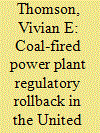

|
|
|
|
|
| Summary/Abstract |
President Trump wants to promote coal and weaken Clean Air Act regulations that affect coal-fired power plants. We analyze which US regions have benefited from air quality improvements realized since adoption of two Clean Air Act power plant rules, the transport and mercury rules, which have been targeted by lobbyists and national officials. For 20 coal states, we create a pre-regulatory emissions scenario for the current (2016) fleet of power plants. Using the US Environmental Protection Agency's CO-Benefits Risk Assessment screening model, we estimate the differences between the impacts of pre-regulatory emissions and current emissions on fine particulate matter (PM2.5) concentrations and on public health. We compare those impacts with voting patterns in the 2016 presidential election and with demographic data. Among the air quality and public health gains of the current situation relative to the pre-regulatory scenario are that: annual average PM2.5 concentrations are lower by 1–5 μg/m3; 17,176–39,291 premature mortalities are avoided for each year of lower emissions; coal mining counties and White, rural counties experience some of the best improvements in air quality; and, in several states, Trump counties benefit more than Clinton counties. We suggest refining these results with atmospheric dispersion models.
|
|
|
|
|
|
|
|
|
|
|
|
|
|
|
|
| 11 |
ID:
162276
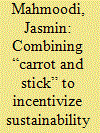

|
|
|
|
|
| Summary/Abstract |
Electrical utilities are a main stakeholder for achieving sustainable policy goals. Effective tariff designs that incentivize electricity savings among consumers can contribute to fulfilling these goals. Prior research suggests that penalties are more effective in promoting behavior change, which can be explained by insights from behavioral economics: Loss aversion describes that people react more strongly to losses (penalties) than to rewards of the same magnitude and go greater lengths to avoid them. However, in markets where consumers freely choose their preferred tariff, it remains a major challenge to persuade consumers to voluntarily subscribe to penalizing tariffs. The present study employed a choice experiment using choice-based conjoint analysis to examine consumer preferences for electricity tariffs that apply a combination of rewards and/or penalties for electricity consumption. Results from a representative sample of Swiss electricity consumers show that consumers prefer tariffs that reward decreases in electricity consumption, rather than tariffs that penalize increases in consumption, but that tariffs combining rewards and penalties achieve substantial potential market acceptance. Direct tariff attractiveness ratings additionally support these findings showing that consumers perceive combined Bonus-Malus tariffs as sufficiently attractive. Future research avenues and implications for marketing strategies and energy policies are discussed.
|
|
|
|
|
|
|
|
|
|
|
|
|
|
|
|
| 12 |
ID:
162293


|
|
|
|
|
| Summary/Abstract |
The technical and financial influences that shape customer investment in behind-the-meter PV and battery systems, provide the means to forecast and quantify customer energy transitions. By utilising techno-economic scenario analysis, this research assists policymakers to understand the impacts of their decisions on future energy market relationships between the customer and utilities. Two case studies are presented, firstly to evaluate the influence of annual increases in usage charges, and secondly the level of feed-in tariff compensation on customer PV and battery investment over a 15-year forecast period located in Perth, Australia. The findings indicate that even without annual increases in usage charges, the falling installation costs of PV and battery technologies will make customer PV-battery systems financially viable within the 15-year forecast period. Additionally, the removal of the feed-in tariff leads to greater reductions in eventual grid consumption. By the end of the forecast period, customer PV-battery systems with the highest financial performance are able to reduce grid consumption above 90% resulting in significant energy resources being transferred out of the energy market. This necessitates the market integration of customer energy resources and provides an opportunity to leverage a combination of customer and utility energy resources for the renewable energy transition.
|
|
|
|
|
|
|
|
|
|
|
|
|
|
|
|
| 13 |
ID:
162337
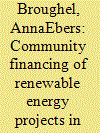

|
|
|
|
|
| Summary/Abstract |
Small-scale investors are gaining recognition as a valuable source of private funding necessary for a successful energy transition. Still, there is limited knowledge about the characteristics of potential investors, especially in community renewable energy projects. This study intends to address this gap and investigates the impact of socio-demographic and socio-psychological characteristics on individuals’ willingness to invest in community renewable energy projects. Our investigation is based on two large-scale representative surveys of 2260 respondents in Austria and Switzerland. The majority of respondents would be willing to invest 1000 to 10,000 CHF/EUR in such a project, with higher amounts in the Swiss sample. Potential investors in Austria tend to be male homeowners with higher incomes, while Swiss investors are more educated. Generally, positive attitudes and beliefs related to renewable energy have a significant impact on investment intention. The largest group of potential investors in both countries can be described as ‘urban wind energy enthusiasts’, who show high acceptance of wind energy installations near their communities. Surprisingly, a significant segment of potential investors is skeptical of a nearby wind installation. Study results can be used by decision-makers to tailor appropriate policy measures and by project developers for communication of the project aims and benefits.
|
|
|
|
|
|
|
|
|
|
|
|
|
|
|
|
| 14 |
ID:
162342
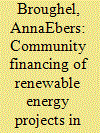

|
|
|
|
|
| Summary/Abstract |
Small-scale investors are gaining recognition as a valuable source of private funding necessary for a successful energy transition. Still, there is limited knowledge about the characteristics of potential investors, especially in community renewable energy projects. This study intends to address this gap and investigates the impact of socio-demographic and socio-psychological characteristics on individuals’ willingness to invest in community renewable energy projects. Our investigation is based on two large-scale representative surveys of 2260 respondents in Austria and Switzerland. The majority of respondents would be willing to invest 1000 to 10,000 CHF/EUR in such a project, with higher amounts in the Swiss sample. Potential investors in Austria tend to be male homeowners with higher incomes, while Swiss investors are more educated. Generally, positive attitudes and beliefs related to renewable energy have a significant impact on investment intention. The largest group of potential investors in both countries can be described as ‘urban wind energy enthusiasts’, who show high acceptance of wind energy installations near their communities. Surprisingly, a significant segment of potential investors is skeptical of a nearby wind installation. Study results can be used by decision-makers to tailor appropriate policy measures and by project developers for communication of the project aims and benefits.
|
|
|
|
|
|
|
|
|
|
|
|
|
|
|
|
| 15 |
ID:
162343


|
|
|
|
|
| Summary/Abstract |
Prior work has suggested that cultivating environmentally friendly energy sources can strike a balance between reducing CO2 emissions and fostering economic growth, yet little is known about whether and how energy-mix policies tap into the balance. Energy-mix is important mainly because maintaining energy supplies exclusively using renewable energy sources is not completely feasible. Our study takes a contingent approach to energy mix policies and suggests that the appropriate mix for reducing carbon emissions is not static but dynamic depending on the developmental stages of national economic systems. We follow the Environmental Kuznets Curve (EKC) hypothesis, the most influential model for relating CO2 emissions to economic development, but depart from it by utilizing multifactor productivity data, rather than the conventional measure of GDP per capita, to capture economic growth. Empirical analyses of OECD countries from 1985 to 2013 show that the best energy policies for OECD countries is the gradual decrease in their relative reliance on natural gas, nuclear power, bio and waste fuels in a short run, over the next about 9, 2 and 5 years respectively, whereas solar and wind power can decrease CO2 in a long run as the economy continues to grow.
|
|
|
|
|
|
|
|
|
|
|
|
|
|
|
|
| 16 |
ID:
162338


|
|
|
|
|
| Summary/Abstract |
Prior work has suggested that cultivating environmentally friendly energy sources can strike a balance between reducing CO2 emissions and fostering economic growth, yet little is known about whether and how energy-mix policies tap into the balance. Energy-mix is important mainly because maintaining energy supplies exclusively using renewable energy sources is not completely feasible. Our study takes a contingent approach to energy mix policies and suggests that the appropriate mix for reducing carbon emissions is not static but dynamic depending on the developmental stages of national economic systems. We follow the Environmental Kuznets Curve (EKC) hypothesis, the most influential model for relating CO2 emissions to economic development, but depart from it by utilizing multifactor productivity data, rather than the conventional measure of GDP per capita, to capture economic growth. Empirical analyses of OECD countries from 1985 to 2013 show that the best energy policies for OECD countries is the gradual decrease in their relative reliance on natural gas, nuclear power, bio and waste fuels in a short run, over the next about 9, 2 and 5 years respectively, whereas solar and wind power can decrease CO2 in a long run as the economy continues to grow.
|
|
|
|
|
|
|
|
|
|
|
|
|
|
|
|
| 17 |
ID:
162333
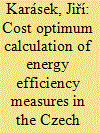

|
|
|
|
|
| Summary/Abstract |
The EU Member States have adopted the Energy Performance of Buildings Directive (EPBD II) in their legislation. This directive introduces new procedures for evaluating the setting of energy performance requirements for buildings, including the so-called cost optimum requirements.
|
|
|
|
|
|
|
|
|
|
|
|
|
|
|
|
| 18 |
ID:
162287


|
|
|
|
|
| Summary/Abstract |
In 2016, solar and wind energy production were greatly curtailed in China, especially in its northwestern region. This paper identifies administrative factors and market barriers as the main causes of renewable curtailment. In 2017, the Northwest Power Grid (NWPG) successfully implemented a variety of approaches to reduce wind and solar curtailment. In this paper, we analyze the change in power generation, expansion of renewable energy delivery, and electricity-replacement projects across provinces that occurred in 2017. While acknowledging the practical results of the NWPG's efforts, we identify challenges that the northwest still faces in integrating renewable energy. We argue that trans-regional administrative barriers are preventing the effective utilization of renewable energy nationwide. To address those barriers, we explore market-based mechanisms for promoting the integration of large-scale renewable energy. In addition to long-term contracts for renewable energy across provinces, both spot-market and the ancillary service market would facilitate the uptake of renewable energy. In addition, price signals should be used to guide peak shaving. Market mechanisms will be insightful to dissolve barriers and enhance utilization of renewable energy throughout the country.
|
|
|
|
|
|
|
|
|
|
|
|
|
|
|
|
| 19 |
ID:
162329
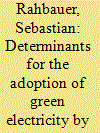

|
|
|
|
|
| Summary/Abstract |
In Germany, the substitution of green electricity (GE) from renewable energy sources for nuclear and fossil electricity is politically intended, yet the demand for GE remains limited. This article provides empirical insight into factors influencing the decision of German small- and medium-sized enterprises (SMEs) to adopt GE. Potentially relevant factors are identified through a review of the previous literature and investigated using logit model analyses based on a large-scale survey of German SMEs regarding GE adoption.
|
|
|
|
|
|
|
|
|
|
|
|
|
|
|
|
| 20 |
ID:
162321


|
|
|
|
|
| Summary/Abstract |
By considering spatial relationships, this study aims to analyse to what extent per capita CO2 emissions are determined by renewable energy consumption, the share of the services sector in GDP, energy intensity and real per capita income. A panel data set composed of 173 countries over the 1990–2014 period is used to estimate an environmental Kuznets curve (EKC) augmented by neighbouring per capita income and energy intensity. Both standard and spatial forms are estimated for seven different sets of countries to assess the robustness of the results. Finally, several forecasts are performed to verify global sustainability and to provide some policy suggestions for the period 2015–2100. The empirical results indicate that (i) most areas support the standard EKC, (ii) there seems to be an inverted U-shaped relationship between neighbouring per capita income and national per capita emissions in Europe, Asia and the World as a whole, (iii) neighbouring energy intensity increases national per capita emissions, and (iv) forecasts show that economic growth will accelerate climate change. However, a steady annual growth in renewable energy consumption and a steady decrease in energy intensity, both close to 2.5%, may guarantee environmental sustainability prior to 2100.
|
|
|
|
|
|
|
|
|
|
|
|
|
|
|
|
|
|
|
|
|